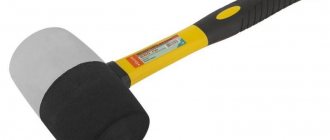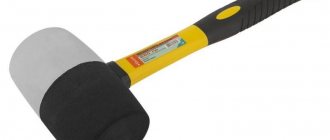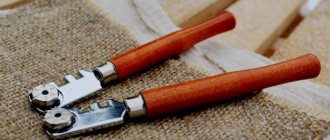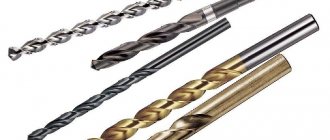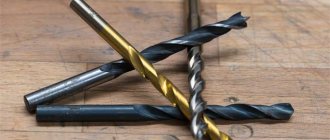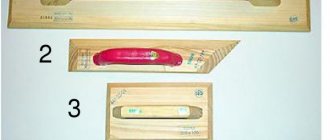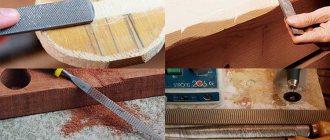Beton-House.com
Website about concrete: construction, characteristics, design. We combine the experience of professionals and private craftsmen in one place
Crowns of different diameters for drilling concrete
Tools with a cavity inside are used for drilling holes and drilling through concrete of any strength. They allow you to make technological holes of different diameters.
Concrete drill bits can be used to prepare sites for mounting sockets and switches. The article introduces what types of tools there are, how to choose them, the principle of operation and the most popular manufacturers.
- Tool selection criteria
Features of using crowns
- Model range of crowns
Where are concrete crowns used?
Concrete crowns (CB) are used to perform the following work:
- Installation of utilities: pipelines, electrical networks, communication lines, security and fire alarms, automation;
- Drilling anchors and other fasteners;
- Fastening technological and electrical structures;
- Fixation of building structures for various purposes.
Mounting type
Diamond bits are equipped with various shanks. The 2 most common types are ½ inch and 1 ¼ inch.
Photo No. 7: the most common fastenings for diamond bits
Diamond core bits with SDS series shanks are also common.
Photo No. 8: diamond bit with SDS series shank
Technical features of crowns for concrete
The crown is made in the shape of a bowl from a metal pipe of a certain diameter. There are holes on the outside to remove dust and concrete particles during drilling. On the reverse side the product is blank and has a hole for attaching a flange with a drill.
- The design can be monolithic or collapsible. The shank has grooves for mounting in electrical equipment.
- Typically, the bit is installed on a hammer drill, impact drill or drill rig.
- To center and ensure the accuracy of the hole, a drill is installed inside the product.
- The working surface has teeth with a special coating.
- Crowns are available in different diameters, which determines the size of the holes being formed.
Collapsible models are equipped with an additional bolt on the flange, allowing you to change the centering drill. The bit is driven by an electric drive of a rotary hammer or drill.
The cutting teeth cut through the surface of the concrete, and the center drill ensures the precision of the hole.
Socket box for drywall
Before installation, it is necessary to remove the plugs in the cable entry area. In this case, a wire with optimal parameters is selected in advance. The optimal dimensions of the element are also important, and therefore the diameter of the product is taken into account when choosing. The most common standard parts are with a diameter of 70 mm. They are suitable for simple sockets, but for a stove you should choose a special device.
In the field and other Sciences are constantly being developed. Every year scientists from around the world make a little opening, slowly moving humanity forward and improving our lives. Explores untouched by man places, first and foremost, of course, on our home planet. However, in the space constantly undergoing work. The distance from the slope to the first outlet in the group should be 150-200mm, and be the same in all rooms.
It is almost impossible to accurately measure these distances before leveling the walls with plaster, therefore the ideal option is to postpone the marking and installation of socket boxes to the moment when all the walls have already been formed. When placing only the socket mechanism in the socket box, you should choose elements with a depth of 45 mm for standard devices. If you plan to install electrical wiring in the socket box, then more spacious options are needed.
In this case, shape plays an important role. Round options are often used, which are easy to install. There are also square models that are optimal for installing non-standard mechanisms or for obtaining more space.
Classification of crowns for concrete
Based on the production material, cutting teeth are divided into 3 types:
- Carbide;
- Tungsten carbide;
- Diamond.
Carbide
Used for impact drilling. The teeth are made of a special carbide alloy. The cutting elements are soldered to the body of the product. Tools are available in diameters from 20 to 100 mm. The shank has an SDS-Plus or SDS-max fastening standard.
Such equipment is available in a wide range of sizes and is affordable. The main disadvantage is the high probability of the cutting part breaking when it hits the reinforcement. The tool is intended for dry use only.
Tungsten carbide
Designed for drilling without impact. The cutting element is covered with a layer of tungsten carbide chips, which cuts through concrete when rotating. Available in different diameters. Sold both individually and in sets consisting of equipment of different diameters.
Spraying from a tungsten carbide alloy allows you to drill into already tiled surfaces, for example, ceramic or porcelain tiles. Like carbide models, such crowns deteriorate almost instantly upon contact with metal.
Diamond
The teeth of the working part are covered with synthetic diamond chips. Diamond is one of the hardest materials, which makes it possible to effectively drill concrete and reinforced concrete. Suitable for dry and wet drilling.
It is recommended to use with moisture, as water speeds up the drilling process and ensures cooling of the equipment. The fluid also extends the life of the tool.
Such crowns are available in different sizes, as they are used to perform a wide range of work in domestic and industrial construction. Diamond-coated crowns have a number of advantages:
- Long service life;
- Resistance to increased loads;
- Possibility of drilling metal-reinforced concrete;
- Wide selection of standard sizes.
The diamond bit is the only drilling equipment suitable for processing reinforced concrete. The key disadvantage of the tool is its relatively high cost.
General description of the tool
For sockets or plumbing pipes, the formation of recesses or through holes of relatively large diameter is required. In this case, you can work with a conventional drill in two ways. If you take a nozzle of the right size, they will have to destroy a large volume of material. Such a decision is not relevant for any reason. The second option is to make several small holes around the circumference. In this case, the walls of the opening turn out to be sloppy, and the middle has to be knocked out. That is, this approach also cannot be called simple and productive.
To solve the task, a crown for socket boxes is one of the most effective tools. Nozzles for working with hard materials are represented by three working elements:
- base with two different tips: a shank for fixing the nozzle in the power tool chuck and a protrusion with an external thread for securing the cutting part;
- a conical or cylindrical centering drill to hold the equipment while working in the exact place and the right direction;
- a drill in the shape of a hollow bowl with a threaded hole at the bottom for fixing to the base of the nozzle and a cutting edge.
An example of a crown in disassembled form Source 220-volt.ru
The main advantage of using a crown for a concrete socket is that the tool contacts only in two places during drilling. A small diameter drill forms a small hole, and the bowl creates a thin strip around the circumference. This makes it possible to relatively quickly create a seat for an installation box or make a through hole in a particular structure.
Varieties by characteristics
Crowns differ from each other in the following design parameters:
- Diameter;
- Length;
- Fastening method (shank design);
- Drilling technology – dry or wet.
The geometric characteristics of the hole depend on the length and diameter. Products with 3 types of fastenings (shanks) are available for sale:
- Hexagon. Securely attaches to a classic drill chuck. The diameter of the tail part is 10 mm.
- SDS-Plus. Fasteners for a classic hammer drill chuck.
- SDS-max. The design is almost the same as SDS-Plus, but with an increased diameter of 20 mm.
In industrial construction, products of the SDS-max design are more often used. Also suitable for domestic construction, provided that a hammer drill with a suitable type of chuck is used. The length of the shank affects the drilling depth.
Recommendations from experts
To work with solid structures made of concrete, brick or stone, you should use a power tool with a power of 1500 watts or more. If an impact mode is provided for a particular crown, then the optimal force is considered to be approximately 14 J. Rotary hammers have these characteristics and the best performance.
An example of a hammer drill with an impact force of 13 J Source 220-volt.ru
Dimensions of crowns for concrete
Purpose of crowns according to drilling method:
- Diamond – dry and wet;
- Tungsten carbide and carbide – dry.
Crowns 68 mm
Accessories with a diameter of 68 mm are most often used in the installation of electrical installations: wiring, socket boxes, distribution boxes. Allows you to make holes for boxes with a diameter of 65-68 mm.
For such work, carbide and diamond tools are used. In professional construction, only diamond products are usually used. When performing electrical installation work you should:
- Observe the Electrical Installation Rules;
- After drilling, remove the remaining concrete from the cavity using a hammer drill or a hammer with a chisel;
- Take breaks from work to prevent overheating of the teeth.
Crowns 72 mm
This standard size is in demand in all areas of construction. Used for installation of electrical communications, pipelines and sewers. Suitable for use with rotary hammers and drills. There are models for dry and wet drilling. Products for dry working technology have additional slots for air cooling.
Diamond accessories with a diameter of 72 mm are designed for hammerless drilling. Allows you to process concrete, reinforced concrete, stone and ceramics. Designed for electrical equipment with a power of 700 W or more.
Crowns 100-120 mm
Crowns with a diameter of 120 mm are considered the largest. Usually used in industrial construction. Designed for drilling equipment with SDS-max fasteners. Used to make large holes, for example, for installing pipes.
Models with a diameter of up to 600 mm are also produced for industrial use, but they are rarely found in retail sales due to low demand.
When working, you should follow these tips:
- Do not put too much pressure on the instrument, this can lead to overheating and even breakage;
- Reinforced concrete can only be drilled using the dry method;
- Reliably install the equipment into the chuck;
- Perform drilling only with the use of personal protective equipment.
Accessories with a diameter of 110 mm or more can only be used with rotary hammers with a power of over 800 W. A low-power drill will quickly overheat, which will lead to failure.
How to make large holes with a hammer drill?
For this procedure, it is best to use a crown, since it has the ability to drill holes of large diameters. Step by step it looks like this:
- Place a mark at the location of the future hole, then double-check all the dimensions, including the diameter of the nozzle itself, several times.
- Place the edge at the drilling site, turn on the hammer drill at minimum speed.
- With each subsequent deepening, increase the speed.
- For convenience and less heating of the working part of the part, you can use water, but avoid getting it on the tool itself.
- After a moment, you will get a perfectly smooth hole of the required diameter.
- After finishing, you can adjust the result using a hammer and chisel.
Popular crown models
Crowns are produced by quite a few Russian, American and European manufacturers. Products (USA) are considered one of the most popular.
Including the manufacturer’s crowns are widespread in Russia. Tooling with a diameter of up to 80 mm is produced, including for processing reinforced concrete products.
Crowns “Diamond Diamond”
Diam Almaz is a domestic manufacturer that produces several types of crowns:
- Grade G. Optimal for processing concrete of the M100-M300 series.
- Grade S. For concrete grades M400-M600.
- Brand TOP. Suitable for processing concrete of increased hardness.
Bosh crowns
The German company produces crowns of various types and sizes. The equipment is popular due to its high quality, but is more expensive compared to domestic analogues. Products with a diameter of 68 mm are most in demand.
DeWalt crowns
is an American manufacturer of construction tools that produces drilling equipment in all standard sizes. The products are suitable for drilling to a depth of up to 80 mm. The instruments belong to the middle price category.
The most popular are 68 mm bits with a diamond-coated cutting part.
Crowns "Distar"
Ukrainian manufacturer of construction equipment. Offers inexpensive products of fairly high quality.
The most popular are diamond-coated crowns.
- The manufacturer offers diamond tools with diameters of 68, 72 and 82 mm.
- The tools have a fairly long service life and provide fast drilling.
There are models for both wet and dry drilling. The products have a special design for more efficient disposal of cuttings during the drilling process.
The range includes not only equipment for concrete and reinforced concrete, but also other hard materials - ceramics, cermets, granite and marble.
Drilling technology
It can be wet or dry. The first technology is used most often and involves manual or automatic supply of liquid. It not only cools the bit, but also flushes away any debris that could damage the tool. Wet drilling is highly productive and is most often used in industry.
Photo No. 5: segmented diamond bit for wet drilling
Dry drilling is chosen when:
- distance from water sources;
- drilling structures with existing finishes, the appearance of which is spoiled by contact with water;
- working with certain types of materials.
Diamond bits for dry drilling differ from conventional ones in two respects.
- Method of soldering diamond elements. Welding is used in the manufacture of dry drilling tools.
- Distance between segments. In dry crowns it is increased. This prevents sludge from accumulating.
Photo No. 6: segmented diamond bit for dry drilling
Note! Drill bits designed for wet drilling cannot be used without a fluid supply. The tool will instantly break.
Photos of the best models of crowns for concrete
Manufacturer
As we have already said, you will find a wide range of diamond bits on the market from various manufacturers. The table below with the characteristics of the most popular models will help you choose the most suitable tool.
Image No. 1: manufacturers of diamond bits, purpose and characteristics of popular models
Drilling steps
When drilling holes in concrete structures, a certain procedure must be followed. It includes the following steps:
- Selection of suitable crowns and tools.
- Applying preliminary markings.
- Removing interior items from the room that may become dusty. Heavy furniture can be covered with fabric or film.
- Use of protective equipment: respirator, overalls, glasses, gloves.
- Enabling drilling mode on the hammer drill panel.
- Drilling holes according to the markings. The tool should be positioned level and without distortion; there is no need to press it into the material.
- Any fragments remaining in the hole can be removed with a chisel or hammer.
Prices
If you want to make just a couple of holes, you can buy Chinese products. You can distinguish it by the lowest price. Some believe that Chinese crowns for socket boxes are not as bad as they seem, and they simply do not know how to work with them. But the point is not the ability to work, but the low quality of the metal itself - it is not made from ore, but from melted down old rusty metal. If you need a lot of holes, it makes sense to buy American products, but European ones (in particular, German ones) will work better (and longer). Russian goods are also represented on the market; their quality is slightly better than China’s, but they are significantly inferior, for example, to American ones, but are slightly ahead of China. Solid-state Chinese ones will cost about 200–300 rubles. a piece. The price tag for professional diamond-coated products starts from 1 thousand rubles. and reaches 12 thousand rubles. The price mainly depends on the diameter and length.
Purpose
Hollow inside equipment for drilling and drilling (through) concrete is designed for removing material of any strength from monolithic structures, which allows you to create technological holes of large and small diameters. And also solve everyday problems, for example, preparing places for installing socket boxes for electrical networks. Crowns greatly speed up and simplify this work, ensuring accuracy and precision.
Return to contents
Features when working with reinforced concrete and tiles
Reinforced concrete drills provide drilling of the strongest materials with maximum diameter and depth, which other similar products cannot cope with. It is thanks to this ability that this model received first place in the rating of tools.
Such a part, unlike Pobedit products, is reliable and durable, and if you purchase it for regular construction and repair work, its high price will pay off in a short period of time. Even the presence of reinforcement cast in concrete will not prevent you from equipping a special place for the socket box using a similar attachment.
Ceramic tiles are a rather difficult material to cut and, especially, drill into a certain surface. Until recently, it was almost impossible to drill into tiles without compromising its integrity; however, the advent of diamond parts has simplified this process. Now ceramics can be used for pipe routing, installation of various fasteners for decorative elements, it can be grooved for laying wires, installing sockets and switches in specially equipped socket boxes.

